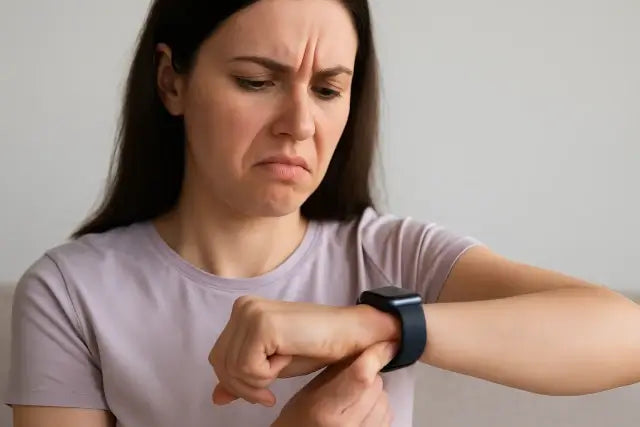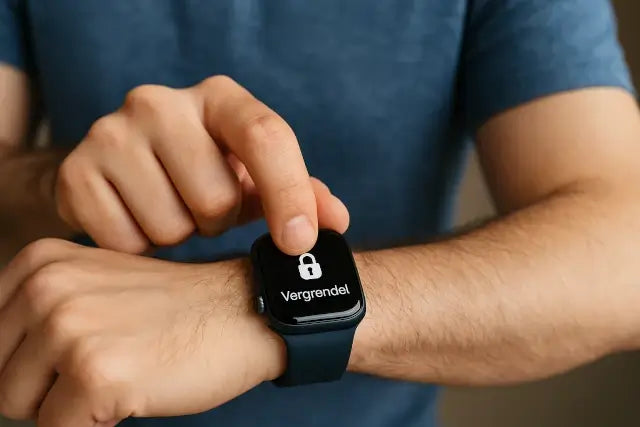How Tight Should an Apple Watch Fit?
Your Apple Watch should fit snugly enough for reliable measurements without causing discomfort or skin irritation, ensuring optimal performance for UK users.
Starting at £399 (Apple Watch Series 10)
Why Fit Matters
The Apple Watch is a sophisticated health and fitness tracker. Accurate heart rate, sleep tracking, and SpO2 measurements depend on proper skin contact.
How Tight Should It Be?
The watch needs firm skin contact for accuracy, but if too tight, it may restrict blood flow or cause discomfort. Too loose, and data becomes unreliable.
Fit Guidelines
- No sliding on the wrist
- Room for one finger between strap and skin
- No red marks after wearing
Fit for Sleep Tracking
Comfort is key at night, but the sensor must still function for sleep data.
Best Nighttime Fit
- Slightly looser than daytime
- No pressure on veins
- Sufficient contact for continuous tracking
Apple recommends a ‘slim-fit’ for sleep, with the sensor stable against the skin without leaving marks.
Fit for Heart Rate Monitoring
Photoplethysmography (PPG) requires direct skin contact. A loose fit allows light leakage, disrupting measurements.
| Fit | Heart Rate Accuracy | Comfort Level | Suitable for Sports? |
|---|---|---|---|
| Loose | Low | High | No |
| Snug | High | High | Yes |
| Tight | Medium to High | Low | Limited |
Apple advises a snug fit during workouts, loosening it afterward for comfort.
Is a Tight Fit Safe?
A tight fit is fine for short periods, like workouts, but prolonged tight wear may cause skin irritation or swelling.
Risks of Too Tight
- Irritation or rash
- Restricted blood flow
- Sensor issues with sweat
Apple Watch Straps and Fit
The strap type affects fit and comfort.
Common Straps
- Sport Band: Highly adjustable, ideal for sports
- Solo Loop: Fixed size, requires precise fit
- Leather Band: Better for daily use
- Milanese Loop: Magnetic, easily adjustable
Solo Loops need accurate sizing to avoid being too loose or tight.
Tips for Wearing Correctly
- Wear above the wrist bone
- Ensure flat skin contact
- Adjust for swelling or temperature changes
- Clean skin and strap for hygiene
FAQs: Apple Watch Fit
How Do I Know If It’s Too Loose?
It slides or shows inconsistent data.
Why Isn’t My Heart Rate Detected?
Poor skin contact; wear it snugger, especially during activity.
Can I Wear It 24/7?
Yes, with proper hygiene and adjusted fit for comfort.
Are Metal Bands Good for Workouts?
Not ideal; choose a flexible, sweat-resistant sport band.
Adjusting Fit by Situation
Fit varies by activity:
- Sports: Tighter for accurate data
- Sleep: Looser for comfort
- Daily Use: Medium fit
Signs of Incorrect Fit
Monitor skin and data for issues:
- Red or irritated skin
- Inaccurate or missing data
- Strap marks on wrist
Adjust immediately if these occur.
Conclusion
Your Apple Watch should be snug for reliable heart rate and sleep tracking but never so tight as to cause discomfort or skin damage. Aim for a fit with room for one finger under the strap. Choose the right strap for your lifestyle with our smartwatch accessories, all with free UK delivery.




Leave a comment
All comments are moderated before being published.
This site is protected by hCaptcha and the hCaptcha Privacy Policy and Terms of Service apply.